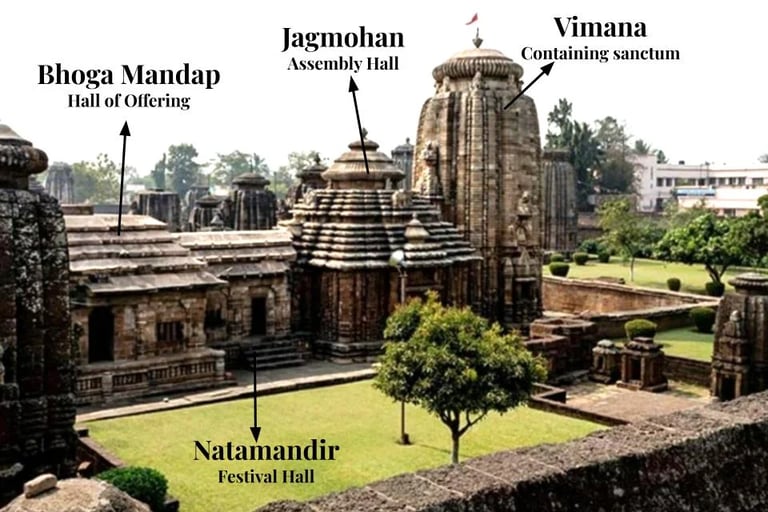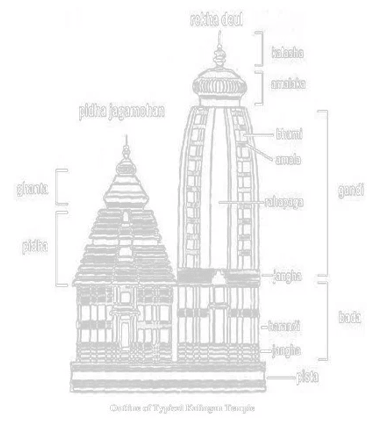Temple Architecture of Odisha (Kalinga Style)
Sociology, as the scientific study of human society and social behavior, shares significant overlap and interconnections with other social sciences. Understanding these relationships is crucial for a holistic comprehension of the human experience
OPSCUPSCGENERAL STUDIES 1
4/15/20255 min read


Temple Architecture of Odisha: The Magnificent Kalinga Style
Odisha temple architecture, also known as Kalinga architecture, represents one of India's most distinctive and sophisticated architectural traditions. Characterized by their unique structural components, intricate carvings, and harmonious integration of religious symbolism, these temples stand as enduring monuments to Odisha's rich cultural heritage and architectural ingenuity. The temples follow a precise structural hierarchy that reflects both practical worship needs and cosmic symbolism, creating a distinct identity within the broader Nagara style of Indian temple architecture.
Historical Development of Odisha Temple Architecture
Early Formative Period (6th-9th Centuries)
The origins of Odisha's temple architecture can be traced back to the 6th century during the rise of the Somavamshi dynasty. This formative period established the foundation for what would later evolve into the sophisticated Kalinga style. Early temples were relatively simple structures constructed primarily from sandstone and laterite, featuring a basic layout consisting of a sanctum sanctorum, a mandapa (hall), and a porch. The Parsurameswar temple in Bhubaneswar, dating to the 7th century, exemplifies this early style with its modest curvilinear sikhara (spire) and oblong pillared jagamohana (assembly hall)2. These early structures laid the groundwork for the architectural innovations that would follow in subsequent centuries.
Golden Age (10th-12th Centuries)
The 10th to 12th centuries marked the golden age of Odisha temple architecture under the patronage of the Ganga dynasty. During this period, temple design grew increasingly elaborate and sophisticated. The culmination of this architectural evolution is best represented by the magnificent Lingaraja temple in Bhubaneswar (11th century), which showcases the mature Kalinga style with its soaring rekha deula and proportionate jagamohana. This period witnessed the standardization of the temple components and the refinement of sculptural techniques that would define the Kalinga architectural tradition.
Structural Components of Odisha Temples
The Basic Two-Part Structure
In its simplest form, an Odisha temple consists of two primary components arranged in axial alignment:
Vimana/Deula (Main Shrine): The sanctuary housing the deity, constructed on a square base with a curvilinear tower known as sikhara2.
Jagamohana (Assembly Hall): A rectangular structure attached to the vimana, serving as a congregation space for devotees.
The Expanded Four-Part Structure
More elaborate temples evolved to include four components in a linear arrangement:
Rekha Deula/Vimana: The tallest structure containing the sanctum sanctorum where the deity resides.
Jagamohana (Assembly Hall): Attached to the vimana, serving as the gathering place for wworshippers
Bhoga Mandapa (Offerings Hall): A hall where food offerings to the deity are prepared and distributed as prasad.
Natya Mandapa (Dance Hall): A separate structure dedicated to music and dance performances as offerings to the deity.
This arrangement can be seen in the attached diagram, which illustrates the typical layout of an Odisha temple with these four components arranged in a hierarchical structure.
Types of Deula (Shrine) in Kalinga Architecture
Odisha temple architecture is distinguished by three distinct types of deula (shrine) structures:
Rekha Deula
The Rekha Deula is characterized by its tall, curvilinear spire (sikhara) rising over a square sanctum. This is the most distinctive feature of Odisha temples, with vertical bands called rathas running along the tower's height, creating a play of light and shadow. The Lingaraja Temple in Bhubaneswar stands as the quintessential example of a Rekha Deula, with its soaring sikhara dominating the cityscape. The term "Rekha" refers to the arrangement of different components in a linear fashion, creating a harmonious progression of architectural elements.
Pidha/Bhadra Deula
The Pidha Deula features a square structure with a pyramidal roof composed of horizontal platforms (pidhas) arranged in a receding formation. Unlike the curvilinear Rekha Deula, the Pidha Deula creates a stepped pyramid effect. The assembly hall (jagamohana) of the Sun Temple at Konark exemplifies this style, demonstrating how this form complements the taller Rekha Deula in a complete temple complex.
Khakhara Deula
The Khakhara Deula represents a unique variation in Odisha temple architecture, bearing some resemblance to the Dravidian Gopuram design of South India3. The name derives from "Khakharu" (pumpkin), reflecting the barrel-shaped roof that distinguishes this style. This form was often used for temples dedicated to goddesses and represents an interesting regional adaptation within the broader Kalinga architectural tradition.
Iconic Examples of Odisha Temple Architecture
Lingaraja Temple, Bhubaneswar (11th Century)
The Lingaraja Temple stands as one of the most magnificent examples of Odisha temple architecture. This 11th-century temple dedicated to Lord Shiva rises to approximately 180 feet and exemplifies the mature Kalinga style2. The temple features a perfect Rekha Deula with a towering curvilinear sikhara and a proportionate jagamohana, showcasing the harmonious integration of structural and decorative elements that define Odisha's architectural achievement 23.
Jagannath Temple, Puri (12th Century)
The Jagannath Temple in Puri, constructed in the 12th century, represents another pinnacle of Kalinga architecture. This massive temple complex is dedicated to Lord Jagannath, a form of Lord Vishnu, and follows the classical four-part structure with a Rekha Deula, jagamohana, natamandira, and andbhoga-mandapa2. The temple's imposing tower dominates the landscape and has become an iconic symbol of Odisha's religious and architectural heritage.
Sun Temple, Konark (13th Century)
Perhaps the most famous of all Odisha temples, the 13th-century Sun Temple at Konark represents the culmination of Kalinga architectural innovation and sculptural excellence. Conceived as a massive stone chariot with twelve pairs of elaborately carved wheels for the sun god Surya, this UNESCO World Heritage site demonstrates the extraordinary technical and artistic achievement of Odisha's temple builders. Though its main tower has collapsed, the surviving structures—particularly the jagamohana with its pyramidal pidha roof—continue to astound visitors with their architectural grandeur and sculptural detail.
Distinctive Architectural and Artistic Features
Sculptural Elements
Odisha temples are renowned for their exquisite sculptures that adorn virtually every available surface. These include depictions of deities, celestial beings, mythological narratives, secular scenes, and erotic imagery that reflected medieval Indian cultural and religious attitudes. The sculptural program follows a hierarchical arrangement, with divine figures occupying higher positions and secular or mundane subjects placed lower on the temple walls.
Decorative Motifs
A distinctive feature of Odisha temple architecture is the repeated use of the horseshoe shape, a motif that evolved from the windows of early Buddhist chaitya-grihas. This motif appears throughout the temple structure, creating visual continuity and reinforcing traditional design elements. Other common decorative features include ornate door frames, elaborately carved pillars, and richly textured wall surfaces that demonstrate the sculptor's virtuosity.
Construction Techniques
Kalinga architects developed sophisticated construction techniques that allowed them to create soaring towers and expansive halls without using mortar. Stone blocks were precisely cut and joined using a mortise and tenon system, while iron dowels provided additional structural integrity. This technological mastery enabled the creation of temples that have withstood centuries of exposure to the elements, including the coastal climate of eastern India.
Cultural and Religious Significance
The temples of Odisha serve not merely as architectural monuments but as living centers of religious practice and cultural expression. Their structural organization reflects Hindu cosmology, with the sanctum representing the cosmic center and the surrounding structures creating a sacred geography that facilitates the worshipper's spiritual journey. The temples continue to function as important pilgrimage destinations and community gathering places, maintaining their relevance in contemporary Indian society.
Conclusion: Legacy and Influence
The temple architecture of Odisha represents one of India's most distinctive and accomplished architectural traditions. Emerging from early experimentation in the 6th century and reaching its zenith during the 10th-13th centuries, Kalinga architecture created a vocabulary of forms that balanced structural innovation with religious symbolism and artistic expression. The temples of Bhubaneswar, Puri, and Konark stand as enduring testimonies to the vision and skill of their creators, contributing significantly to India's architectural heritage and influencing temple design throughout eastern India.
The legacy of Odisha temple architecture continues to inspire contemporary architects and artists, while its surviving monuments attract scholars, pilgrims, and tourists from around the world. As important repositories of India's cultural heritage, these temples embody the artistic achievement, religious devotion, and technical ingenuity that characterized medieval Odisha, preserving this legacy for future generations to study and admire.




